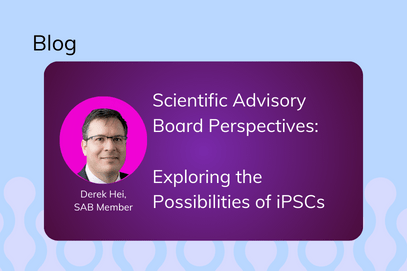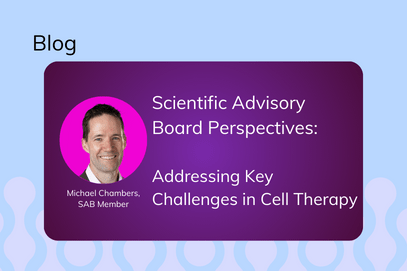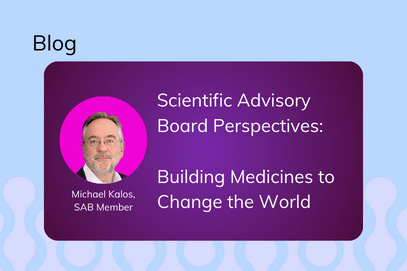RoslinCT Blog Series: Scientific Advisory Board Perspectives
Michael Mendicino, RoslinCT SAB Member
Navigating an Evolving Landscape
As the advance of cell-based therapies and innovative manufacturing and platform techniques continues at a rapid pace, so does the evolution of the regulatory landscape. The move from autologous to allogeneic approaches, growth in iPSC-based development, the advent of new gene editing technologies, and the use of non-vector-based gene modification are just some of the factors creating both opportunities and challenges for developers and regulators.
We recently spoke with RoslinCT’s Scientific Advisory Board member Michael Mendicino, Ph.D., about trends in the cell and gene therapy industry, the regulatory environment, and the need to think strategically about chemistry, manufacturing, and controls (CMC). Dr. Mendicino has extensive R&D and regulatory experience in the fields of cell and gene therapy, both with biotechnology companies and at the Food and Drug Administration (FDA). While at the FDA, he spent a good portion of this time as a CMC reviewer and working on pan-IND assessment projects that were published in Cell Stem Cell and Nature Biotechnology.
Dr. Mendicino established a consulting firm, Hybrid Concepts International, which has grown to over 25 senior experts over 8 years, focused on cell and gene and related tools/technology. HCI has served over 150 organizations in the space, providing all disciplinary expertise (CMC, regulatory, Quality, preclinical, clinical and publishing) to a good-sized slice of the market. Michael also volunteers his time with the leading professional societies and other non-profits in the space, such as the Alliance for Regenerative Medicine (ARM), the International Society for Cell and Gene Therapy (ISCT) and the Standards Coordinating Body (SCB).
Keeping Pace with Innovation
“It is very challenging for both industry and regulators to keep up with the breadth of innovations impacting the field of cell therapy,” noted Dr. Mendicino. “Assessing the advantages and disadvantages of trends and innovations is essential, and in the case of CDMOs such as RoslinCT, they must prioritize each in terms of the value offered to client projects. For example, there has been a lot of interest in the use of induced pluripotent stem cells (iPSCs) to treat disease and RoslinCT made this an area of focus.” RoslinCT was one of the first CDMOs in the world to produce clinical-grade human iPSCs.
Some of these allogeneic therapies, depending on the gene editing approach, could be universal donor-like or could require a limited amount of matching to enable partial or fully off-the-shelf approaches. Another interesting area of innovation is cell therapy without the cells – in other words, use of extracellular vesicles or exosomes. Moving to an acellular product that does not contain living cells could offer inherent advantages including simplifying the treatment complexity of cell therapy.
“Because of these innovations, there is an evolution at the FDA, which is very important,” noted Dr. Mendicino. Between the Prescription Drug User Fee Act (PDUFA VII) and the recent Omnibus bill, there has been an effort to improve the ability for the FDA to more effectively regulate as well as providing the industry more options to interact with the Agency and utilize pilot programs. For example, the Center for Biologics Evaluation and Research (CBER) recently established the Office of Therapeutic Products (OTP) and is hiring additional staff. The “super office” is the result of a reorganization of the Center’s Office of Tissues and Advanced Therapies.
Getting Strategic about CMC
Within an evolving regulatory landscape, there are many considerations that must be top of mind for cell therapy developers, including comparability and potency. This is especially true if the developer is not working with an educated and knowledgeable partner like RoslinCT. “If the innovator company is doing it alone and lacks the experience, human resources and facilities to do so, there might not be a complete appreciation for all the changes being made during the evolution of their CMC process,” said Dr. Mendicino.
If sufficient attention is not paid to CMC, it could come back to haunt a developer upon submission of an IND, or as they transition from an early to late stage of clinical development or to marketing authorization. These changes are particularly important and need to be considered prospectively and perhaps pooled together at certain regulatory milestones that make the most sense. The right CDMO partner can be an important collaborator for CMC-related activities.
“Potency is another very important area that also requires collaboration, scientific understanding, and comprehensive product characterization over time,” noted Dr. Mendicino. The product developer should be spending the appropriate amount of time on that in a development stage-appropriate manner, and not only working with the FDA on the potency development plan over time but also working with their CDMO. What assays will be transferred to the CDMO and how the interplay between the developer and the contract organization occurs are two key areas of consideration.”
Decisions related to how CMC is managed are critically important. If there is breakthrough-level clinical data in the first human trial, CMC information could end up being a significant component of what is filed in an expedited pathway designation, or an accelerated approval-based BLA filing. In these cases, CMC development should maintain an eye towards commercialization even in the early clinical phases. “If you do not have a good CDMO partner, and if you are not working with the FDA early and asking the right questions as it pertains to CMC, significant delays could result.”
The scale of production for the therapeutic candidate also plays a role in developing CMC processes, notes Dr. Mendicino. “If you are working in a rare disease where there is a limited commercial market, it might make sense to not spend too much time and money to optimize and scale the CMC process before the initial marketing approval. If there is a significant market opportunity and significant clinical data, however, it makes sense to think about scaling up earlier in clinical development.”
As the cell-based therapy industry continues to evolve, navigating the complexities and maximizing the benefit for patients will rely on the convergence of innovator companies, experienced CDMOs, and regulators. Close collaboration across these and other stakeholders will accelerate the advancement and application of novel approaches to create new therapies that are both safe and effective.


